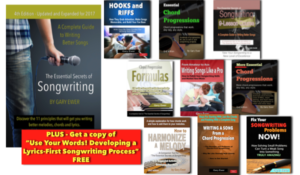For most songs, if you speak of the hook, you’re talking about the chorus, and most likely the start of the chorus. Sometimes the hooky bit might be the end of the chorus, like Jimmy Gilmer and the Fireballs’ 1963 hit “Sugar Shack”.
For pop songs, the hook has been a perennially essential ingredient. Because the hook is like a large flag that gets waved by a song, there’s a perception that a song can’t succeed without an obvious one.
 If you’re not sure how to create song hooks that can grab audience attention, you need to read “Hooks and Riffs: How They Grab Attention, Make Songs Memorable, and Build Your Fan Base.” It’s part of “The Essential Secrets of Songwriting 10-eBook Bundle”
If you’re not sure how to create song hooks that can grab audience attention, you need to read “Hooks and Riffs: How They Grab Attention, Make Songs Memorable, and Build Your Fan Base.” It’s part of “The Essential Secrets of Songwriting 10-eBook Bundle”
That’s not strictly true. There are lots of things that can attract listeners quite apart from whatever we might call an obvious hook. But that’s a topic for another blog article. In this post, I want to talk about the fact that most songs have several elements that rise to being a hook.
In that sense, hooks can get layered in such a way that there is a kind of build up of hooks until we reach the most prominent one.
Let’s say that you’ve come up with a catchy chorus hook, and so the chorus of your song feels strong and secure. Now you need a verse to lead into it. You might think that in the working out of a verse, you can stop thinking about hooks, but I recommend creating at least one other hook that might live in the verse, or at least in the intro.
There are some great classic rock examples of this, such as Stevie Wonder’s “Superstition” and Michael Jackson’s “Beat It.” Both start with catchy intro hooks that are every bit as important to the attraction level of the song as the main chorus hook.
Beyond those great song intros, you get an instrumental backing riff that, while not really a hook (more of a rhythmic motif), also works to captivate and pull the listener in.
In “Beat It”, once the chorus hook hits, it’s like you’ve arrived at a mountain top, and you can hear that everything has been leading up to it. In “Superstition”, the hooky bit happens more toward the end of the chorus (“Superstition ain’t the way.”) But just as in “Beat It,” all the hook-like elements before that chorus hook lead up to the final line.
In your own songs, you want create a strong chorus hook, but you also want to give thought to hook-like elements and rhythmic motifs in the verse that might lead up to that chorus event. To not consider lesser verse hooks means that you hope that your audience will stick with a less-than-stellar verse to finally and more thoroughly enjoy the chorus.
The task of making a verse attractive also often involves the long, slow build. A song like Taylor Swift’s “I Did Something Bad” (Taylor Swift, Max Martin, Shellback) demonstrates this quite well. Many elements of that gradual build involve hook-like characteristics, like the opening pizzicato-like string effect, and then the long, gradual build in the song’s dynamic (loudness).
So most successful song verses will feature either a verse hook or, in absence of that, a kind of long slow build up of musical energy that gets released at the chorus. In doing that, you fulfill an important songwriting principle: that musical energy should ebb and flow over the course of a song, but should be mostly higher by its conclusion.
 Written by Gary Ewer. Follow Gary on Twitter.
Written by Gary Ewer. Follow Gary on Twitter.
 “The Essential Secrets of Songwriting” 10- eBook bundle comes with a free copy of “Use Your Words! Developing a Lyrics-First Songwriting Process.” Discover the power and excitement that comes from putting your lyrics front and centre in the songwriting process.
“The Essential Secrets of Songwriting” 10- eBook bundle comes with a free copy of “Use Your Words! Developing a Lyrics-First Songwriting Process.” Discover the power and excitement that comes from putting your lyrics front and centre in the songwriting process.










